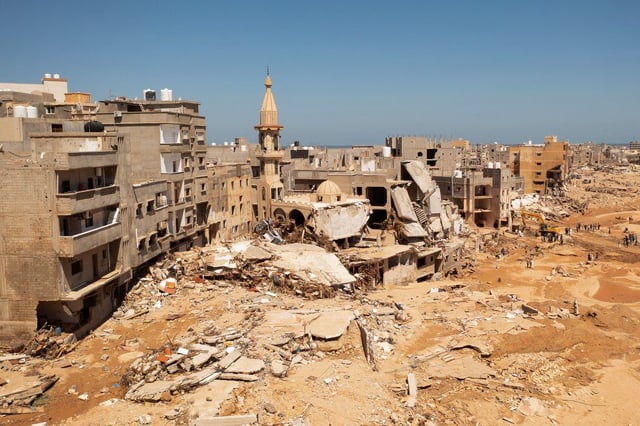Newsmatro

In a devastating aftermath of heavy rains and breached dams, the Libyan Red Crescent has reported that the death toll in Libya’s coastal city of Derna has surged to a staggering 11,300, with a further 10,100 individuals reported as missing. This tragedy has underscored the vulnerabilities of Libya, an oil-rich nation mired in conflict since the 2011 uprising that ousted longtime ruler Moammar Gadhafi.
What Happened in Libya?
The catastrophe in Libya was triggered by Daniel, an exceptionally powerful Mediterranean storm, which resulted in deadly flooding across eastern Libya. The city of Derna bore the brunt of this disaster, as two dams outside the city collapsed amid the torrential rainstorm. The breach of these dams unleashed floodwaters into the city, causing extensive damage to buildings and sweeping away numerous residents, tragically resulting in a significant loss of life. In total, approximately 170 lives were claimed by the storm in various parts of the country.
Impact of Conflict on Disaster
This devastating event has not only revealed the intensity of the storm but also exposed Libya’s vulnerability due to its prolonged internal conflict. For much of the past decade, Libya has been divided between rival governments—one in the east and the other in the capital, Tripoli. This division has led to the neglect of critical infrastructure, including the maintenance of dams.
The two dams outside Derna, which gave way to the floodwaters, were constructed in the 1970s. Shockingly, a report by a state-run audit agency in 2021 revealed that these dams had not been adequately maintained, despite the allocation of over 2 million euros for this purpose in 2012 and 2013.
In response to this tragedy, Libya’s Tripoli-based prime minister, Abdul-Hamid Dbeibah, acknowledged the maintenance issues during a Cabinet meeting and called for an urgent investigation into the dams’ collapse.
Remarkably, this disaster prompted a rare moment of unity, with government agencies across Libya rallying to provide assistance to the affected areas. While the Tobruk-based government in eastern Libya has taken the lead in relief efforts, the Tripoli-based western government has allocated substantial funds for reconstruction in Derna and other affected towns. An armed group in Tripoli has also dispatched humanitarian aid to the region.
Current Situation
In the wake of this disaster, Derna has begun the process of burying its dead, primarily in mass graves. The health minister of eastern Libya, Othman Abduljaleel, reported that over 3,000 bodies had been buried by Thursday morning, with an additional 2,000 bodies still being processed. Rescue teams continue to search the city’s ruined buildings, and divers are scouring the sea off Derna for any further victims.
However, it is feared that many individuals may remain buried under piles of mud and debris, including overturned vehicles and concrete rubble, which can reach heights of up to 4 meters (13 feet). The floods have significantly hampered the arrival of heavy equipment and machinery, as many roads leading to the affected areas have been washed out or blocked.
To address the urgent needs arising from this catastrophe, Libya’s eastern-based parliament, The House of Representatives, approved an emergency budget of 10 billion Libyan dinars, roughly equivalent to $2 billion.
Casualty Figures
As of Thursday, the Libyan Red Crescent has reported 11,300 fatalities, with an additional 10,100 individuals reported as missing. However, local officials have suggested that the actual death toll may be significantly higher.
Derna Mayor Abdel-Moneim al-Ghaithi stated in an interview with the Saudi-owned Al Arabia television station that the death toll could potentially reach 20,000, given the number of neighborhoods devastated by the flooding.
The storm also claimed around 170 lives in other parts of eastern Libya, including the towns of Bayda, Susa, Um Razaz, and Marj, according to the health minister.
The victims in eastern Libya included at least 84 Egyptians, whose remains were repatriated to Egypt. Reports have also indicated that dozens of Sudanese migrants lost their lives in the disaster.
Aid and Relief Efforts
The catastrophic floods have resulted in the displacement of at least 30,000 people in Derna, with several thousand more forced to leave their homes in other eastern towns. The destruction of access roads to Derna initially hindered the arrival of international rescue teams and humanitarian assistance. However, local authorities have since cleared some routes, allowing humanitarian convoys to reach the city in recent days.
The U.N.’s International Organization for Migration has reported urgent needs for 250,000 Libyans most affected by this disaster and has issued an emergency appeal for $71.4 million to address these needs. It is estimated that approximately 884,000 people across five provinces are residing in areas directly impacted by the heavy rainfall and flooding.
The International Committee of the Red Cross has supplied 6,000 body bags to local authorities and provided medical, food, and other essential supplies to the hard-hit communities.
International assistance has begun to arrive, with several countries, including Egypt, Algeria, Tunisia, and Italy, sending aid and rescue teams to Libya. The United States, represented by President Joe Biden, has pledged to provide monetary support to relief organizations and collaborate with Libyan authorities and the United Nations to extend further assistance to those affected.
This report includes contributions from Associated Press journalists Samy Magdy in Cairo and Jack Jeffery in London.